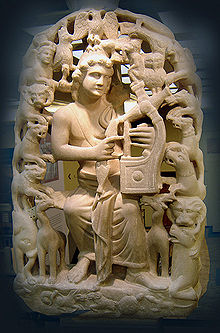Byzantine Music
| Music of Greece | |
|---|---|
 |
|
| General topics | |
|
|
| Genres | |
|
|
| Specific forms | |
| Media and performance | |
| Music awards |
|
| Music charts | |
| Music festivals | |
| Music media |
|
| Nationalistic and patriotic songs | |
| National anthem | "Hymn to Liberty" |
| Regional music | |
| Related areas | Cyprus, Pontus, Constantinople, South Italy |
| Regional styles |
|
Byzantine music (Modern Greek: Βυζαντινή μουσική), in a narrow sense, is the music of the Byzantine Empire. Originally it consisted of songs and hymns composed to Greek texts used for courtly ceremonials, during festivals, or as paraliturgical and liturgical music. The ecclesiastical forms of Byzantine music are the best known forms today, because different Orthodox traditions still identify with the heritage of Byzantine music, when their cantors sing monodic chant out of the traditional chant books like sticherarion which in fact consisted of five books, and the heirmologion. Byzantine music did not disappear after the fall of Constantinople. Its traditions continued under the Patriarchate of Constantinople which was annexed by the Islamic Ottoman ruler Sultan Mehmed II in 1453, and granted administrative responsibilities over all Orthodox Christians. During the decline of the Ottoman Empire in the 19th century, burgeoning splinter nations in the Balkans declared autonomy or "autocephaly" against the Ecumenical Patriarchate. The new self-declared patriarchates were independent nations defined by their religion. In this context, Christian religious chant practiced in the Ottoman empire, Bulgaria and Greece among other nations, was based on the historical roots of the art tracing back to the Byzantine Empire, while the music of the Patriarchate created during the Ottoman period was often regarded as "post-Byzantine." This explains why Byzantine music refers to several Orthodox Christian chant traditions of the Mediterranean and of the Caucasus practiced in recent history and even today, and this article cannot be limited to the music culture of the Byzantine past.
The tradition of eastern liturgical chant, encompassing the Greek-speaking world, developed in the Byzantine Empire from the establishment of its capital, Constantinople, in 330 until its fall in 1453. It is undeniably of composite origin, drawing on the artistic and technical productions of the classical Greek age and inspired by the monophonic vocal music that evolved in the early Greek Christian cities of Alexandria, Antioch and Ephesus. It was imitated by musicians of the 7th century to create Arab music as a synthesis of Byzantine and Persian music, and these exchanges were continued through the Ottoman Empire until Istanbul today.
...
Wikipedia
